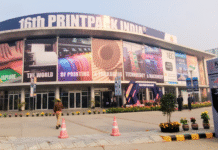Correspondent Priyanka Tanwar interacted with poet and translator Abhay K at the Jaipur Literature Festival about poetry, translations, the rich landscape of Bihari literature, inspiration, and cover designs.
Edited excerpts:
Indian Printer & Publisher (IPP) – How is your experience at the Jaipur Literature Festival?
Abhay K – It has been a very stimulating and inspiring experience to be here. Only at JLF do you get to meet Nobel laureates, you get to meet the luminaries of Urdu literature such as Gulzar Sahab and Javed Akhtar at the same time, you can meet the president of the Royal Society of Literature of the UK, other Booker winners and poets, writers, journalists, people from all walks of life, mathematicians, scientists and so on. I think it’s a truly rich experience for a writer and diplomat like me, who needs such interactions to stay inspired and motivated. The Jaipur Literature Festival does it year after year.
It brings together the people who have contributed significantly in the field of literature every year. And it’s not the same – it renews the speakers, the writers who have contributed in that particular year, have published new works, and also makes it possible for them to be here together. And makes it possible not only to speak and interact with the audience but to also meet each other. I think this is something very, very special. I feel so lucky to be part of it.
I’ve been coming to JLF since 2014. The first time I was a speaker in 2014 when my book The Seduction of Delhi was launched here. A number of other books have been released at the Jaipur Literature Festival in subsequent years. For example, Capitals: A Poetry Anthology in 2017. I was again here in 2020 and now in 2023.
IPP – Tell us about your most recent work.
Abhay K – I have edited The Book of Bihari Literature, which is an anthology of writings from about 2,600 years of Bihar’s literature in various languages such as Magahi (Magadhi), Bhojpuri, Angika, Bajjika, Maithili, Urdu, Hindi, Sanskrit, and Pali. These have all been translated into English. So, for the first time, readers outside Bihar, or even within Bihar, are getting to see literature from so many languages presented in one book. This has never been done before. Many short stories from Magahi or Angika or Bajjika have been translated for the first time ever. The book is getting a great response both from the reviewers as well as from the audience.
IPP – Would you like to comment on the literary and publishing scene in Bihar?
Abhay K – Bihar, particularly, is producing lots of literature in its various languages – Magahi, Bhojpuri, Angika, Bajjika, Maithili, Urdu, Hindi, Sanskrit, Pali and English. There is a lot of creativity at the grassroots level. You can see from this book how much is happening away from the attention of the Hindi readers maybe, or the mainstream Urdu publishing or Hindi publishing. All this work is happening in these languages. You have a vibrant literary scene there which is not visible at the national level.
IPP – What inspired you to create this collection?
Abhay K – I had the experience of editing various books. I thought I must do one book for Bihar – from where I am (Nalanda). I realized that I knew very little about literature in my own mother tongue Magahi. I wanted to explore that and then I wanted to explore what is there in other languages of Bihar. I enjoy literature from the grassroots. It was sort of paying a homage and paying a tribute to my own state, my own mother tongue, and the sister mother tongues.
IPP – The works in the volume are quite diverse. How did you select them?
Abhay K – It was difficult to find works in these languages. Once I started reading them, I liked the humanness, and the stories that touched my heart. There’s a story about an old couple who are struggling to get a blanket in the biting cold winter in Bihar, and there’s another about a mother who wants to get married but the family opposes the idea because she’s old. But she needs company and decides to get married. Only the daughter supports her, saying ‘I truly understand you’. There are so many such stories. There’s this first Dalit writer from Bihar, Hiradom, who writes Achoot ki Shikayat. A story called Invisible Bond from Bajjika is about early growing up together – a love relationship between a landlord and the maid. They grew up together and didn’t know the difference. There are so many such stories in this book which are very touching and refreshing.
IPP – What do you think is the role of translations in the Indian publishing scene right now?
Abhay K – I think translations are very important for a country like India because we have so many languages, and there’s so much of treasure in the regional languages. Those stories, poems and novels need to be translated into English so that people abroad or even in metros such as Delhi or Kolkata can get to know about the richness of Indian literature. Without translations, it won’t be possible for them to read all that is there. We need more translations.
IPP – In your opinion, what steps can the government take to improve translations in India?
Abhay K – I think we need a national translation agency at the earliest, that can do quality translations, or which can at least not directly, but indirectly, support translators and can publish translated works in various foreign languages. I think we need a culture of translation in India – an ecosystem of translations that needs to be supported both by the government and the private sector.
IPP – You wear many hats – poet, translator, anthologist. Which one is your favorite and why?
Abhay K – I think they complement each other for me. It’s something I truly enjoy doing. As a diplomat, I get to travel a lot, and it helps me to write my poetry. As a poet, it helps me to become a better diplomat because I can connect with people at a deeper level. I think it also helps me with my language as a diplomat. They complement each other for me. There have been many poet diplomats in the past who have excelled – Octavio Paz, who was the Mexican ambassador to India and also a Nobel laureate in literature. There are so many others.
IPP – How have you evolved as a poet and a translator since you started?
Abhay K – I started writing love poems, and I’m still writing love poems. I translated Kalidasa’s Meghdoot and Ritusamhara because I wanted to write my own poem titled Monsoon from Madagascar to India. It is a love poem that brings out Meghdoot and Ritusamhara into the 21st century and introduces a new Kalidasa to the readers. Also, I think, with growing time, you become more careful about using words, and you get that music of words more easily.
IPP – Cover designs play a significant role in making that first impression on the readers. How do you select the cover designs of your books?
Abhay K – I like cover designs which sort of really impress me. When I can say, wow! I don’t agree with anything less. It has to have a wow factor, otherwise, it doesn’t work for me.
IPP – And how do you select the titles for your books?
Abhay K – The titles are mostly about places – like The Seduction of Delhi, or The Eight-eyed Lord of Kathmandu, or The Prophecy of Brasilia, or The Alphabets of Latin America: A Carnival of Poems, or The Magic of Madagaskar. My next book is called In the Light of Africa. All these have places in the title. There is also Monsoon and I have a new book coming up called Celestial, which takes one on a journey to the constellations.
It has to be very evocative, and there has to be an element of curiosity and mystery. Like, who is the eight-eyed lord of Kathmandu, or what is the seduction of Delhi, or what is the magic of Madagascar?
IPP – Would you like to give a message to our readers?
Abhay K – Keep reading! I think reading is so important to grow and to keep oneself motivated and disciplined.
Please read more poetry. Many don’t read poems as they think it is difficult. But poetry is something that gets easier once you read. You can read it in a short span of time and can get so much more in a stanza. Poetry is an essential language.
It’s very important for writers to interact with readers so they can know if they are being read or liked. I would request more readers to leave comments so that there’s feedback, whether good or bad.
















